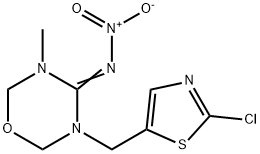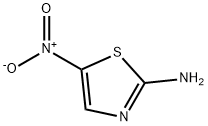TIZOXANIDE
- CAS NO.:173903-47-4
- Empirical Formula: C10H7N3O4S
- Molecular Weight: 265.25
- MDL number: MFCD07484970
- SAFETY DATA SHEET (SDS)
- Update Date: 2024-11-19 23:02:33

What is TIZOXANIDE?
Description
Tizoxanide is an active metabolite of the antiparasitic nitazoxanide . Tizoxanide is formed from nitazoxanide via deacetylation of nitazoxanide in the stomach. It is active against M. tuberculosis (MIC = 16 μg/ml). It also reduces the growth of the disease-causing parasites L. mexicana and T. cruzi in vitro (IC50s = 6.2 and 17.5 μM, respectively), inhibits influenza A replication (EC50s = 0.3-1 μM), and inhibits hepatitis B and hepatitis C virus replication (EC50 = 0.15 μM for both).
Chemical properties
Light Yellow Powder
The Uses of TIZOXANIDE
A metabolite of Nitazoxanide (N490100); a potent inhibitor of hepatitis B virus and hepatitis C virus. Kills Mycobacterium tuberculosis.
The Uses of TIZOXANIDE
A metabolite of Nitazoxanide; a potent inhibitor of hepatitis B virus and hepatitis C virus.
What are the applications of Application
Tizoxanide is A potent inhibitor of hepatitis B virus and hepatitis C virus
Definition
ChEBI: Desacetyl-nitazoxanide is a member of salicylamides.
in vitro
previous study found that tizoxanide showed potent inhibition of both hbv and hcv replication. tizoxanide also exhibited selective inhibition of intracellular hbv replication and extracellular virus production by 2.2.15 cells. tizoxanide could selectively reduce intracellular hcv replication in ava5 cells. moreover, the combination of tizoxanide with either recombinant human interferon alpha 2b (ifnα), or an ns5b (hcv polymerase) inhibitor, 2′-c-methyl cytidine, resulted in synergistic interactions against hcv replication. in addition, antiviral activities of tizoxanide against a full-length genotype 1a replicon were equivalent to that observed for ava5 cells [1].
in vivo
animal study in an immunosuppressed rat model suggested that relapses were less frequent after treatment with nitazoxanide, the parent drug of tizoxanide, than with the non-absorbable sinefungin and paromomycin [2].
References
[1] korba be,montero ab,farrar k,gaye k,mukerjee s,ayers ms,rossignol jf. nitazoxanide, tizoxanide and other thiazolides are potent inhibitors of hepatitis b virus and hepatitis c virus replication. antiviral res.2008 jan;77(1):56-63.
[2] gargala g,delaunay a,li x,brasseur p,favennec l,ballet jj. efficacy of nitazoxanide, tizoxanide and tizoxanide glucuronide against cryptosporidium parvum development in sporozoite-infected hct-8 enterocytic cells. j antimicrob chemother.2000 jul;46(1):57-60.
Properties of TIZOXANIDE
| Melting point: | 279-281°(dec) |
| Density | 1.644±0.06 g/cm3(Predicted) |
| storage temp. | Sealed in dry,Room Temperature |
| solubility | DMSO (Slightly), Methanol (Slightly, Heated) |
| form | Solid |
| pka | 6.70±0.50(Predicted) |
| color | Off-White to Pale Yellow |
Safety information for TIZOXANIDE
Computed Descriptors for TIZOXANIDE
New Products
(S)-3-Aminobutanenitrile hydrochloride 4-Methylphenylacetic acid N-Boc-D-alaninol N-BOC-D/L-ALANINOL Tert-butyl bis(2-chloroethyl)carbamate 3-Morpholino-1-(4-nitrophenyl)-5,6-dihydropyridin- 2(1H)-one Furan-2,5-Dicarboxylic Acid Tropic acid 1-Bromo-3,5-Di-Tert-Butylbenzene S-2-CHLORO PROPIONIC ACID ETHYL ISOCYANOACETATE 2-Bromo-1,3-Bis(Dimethylamino)Trimethinium Hexafluorophosphate 4-IODO BENZOIC ACID 3-NITRO-2-METHYL ANILINE 1-(2,4-DICHLOROPHENYL) ETHANAMINE (2-Hydroxyphenyl)acetonitrile 4-Bromopyrazole 2-(Cyanocyclohexyl)acetic acid 4-methoxy-3,5-dinitropyridine 1-(4-(aminomethyl)benzyl)urea hydrochloride 2-aminopropyl benzoate hydrochloride diethyl 2-(2-((tertbutoxycarbonyl)amino) ethyl)malonate tert-butyl 4- (ureidomethyl)benzylcarbamate Ethyl-2-chloro((4-methoxyphenyl)hydrazono)acetateRelated products of tetrahydrofuran
You may like
-
 Tizoxanide CAS 173903-47-4View Details
Tizoxanide CAS 173903-47-4View Details
173903-47-4 -
 Tizoxanide 95.00% CAS 173903-47-4View Details
Tizoxanide 95.00% CAS 173903-47-4View Details
173903-47-4 -
 Tizoxanide >98% (HPLC) CAS 173903-47-4View Details
Tizoxanide >98% (HPLC) CAS 173903-47-4View Details
173903-47-4 -
 1975-50-4 98%View Details
1975-50-4 98%View Details
1975-50-4 -
 2-HYDROXY BENZYL ALCOHOL 98%View Details
2-HYDROXY BENZYL ALCOHOL 98%View Details
90-01-7 -
 2-Chloro-1,3-Bis(Dimethylamino)Trimethinium Hexafluorophosphate 221615-75-4 98%View Details
2-Chloro-1,3-Bis(Dimethylamino)Trimethinium Hexafluorophosphate 221615-75-4 98%View Details
221615-75-4 -
 14714-50-2 (2-Hydroxyphenyl)acetonitrile 98+View Details
14714-50-2 (2-Hydroxyphenyl)acetonitrile 98+View Details
14714-50-2 -
 118753-70-1 98+View Details
118753-70-1 98+View Details
118753-70-1




